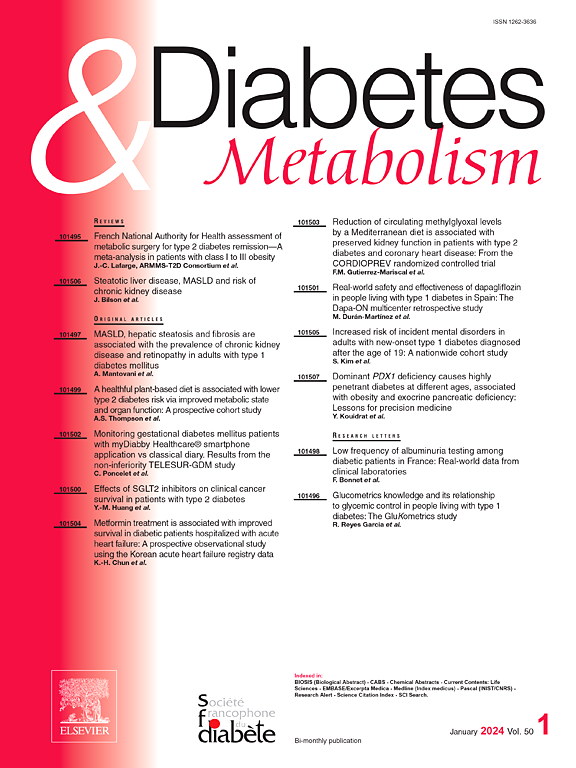Epicardial adipose tissue volume and diabetic retinopathy
IF 4.7
2区 医学
Q1 ENDOCRINOLOGY & METABOLISM
引用次数: 0
Abstract
Introduction
We explored the association between epicardial adipose tissue (EAT) volume and diabetic retinopathy.
Methods
We used clinical data from a monocentric mixed retrospective and prospective observational study of 1093 individuals living with diabetes who had a computed tomography (CT) scan in order to calculate their coronary artery calcium (CAC) score. This scan was also used to compute EAT volume. For the present study, only persons whose diabetic retinopathy status was known (i.e., yes/no) were included.
Results
We included 1037 individuals living with diabetes (type 2 79.1 %, type 1 14.8 %, other types 6.2 %) for 14.6 ± 9.9 years. Mean body mass index was 29.4 ± 5.9 kg/m², HbA1c was 8.7 ± 2.2 %, 38.2 % had diabetic retinopathy, and EAT volume was 93 ± 40 cm3. Diabetic retinopathy was positively associated with North African ethnicity, type 1 diabetes, longer diabetes duration, higher HbA1c levels, and more hypertension and diabetes-related complications (nephropathy, neuropathy, macroangiopathy and a high CAC score). EAT volume was lower in patients with diabetic retinopathy than in those without (87 ± 37 vs 97 ± 42 cm3, P < 0.0001), independently of confounders (per 10cm3 increase: odds ratio 0.89 [95 % confidence interval 0.84;0.93], P < 0.0001).
Conclusion
We found an unexpected negative association between the volume of EAT—a proinflammatory tissue—and diabetic retinopathy prevalence. This finding warrants further mechanistic investigation.
心外膜脂肪组织体积与糖尿病视网膜病变。
前言:我们探讨了心外膜脂肪组织(EAT)体积与糖尿病视网膜病变之间的关系。方法:我们使用了一项来自1093例糖尿病患者的单中心混合回顾性和前瞻性观察研究的临床数据,这些糖尿病患者进行了计算机断层扫描(CT),以计算他们的冠状动脉钙(CAC)评分。该扫描也用于计算EAT体积。在本研究中,仅包括糖尿病视网膜病变状态已知的人(即,是/否)。结果:纳入1037例糖尿病患者(2型79.1%,1型14.8%,其他型6.2%),随访14.6±9.9年。平均体重指数为29.4±5.9 kg/m²,糖化血红蛋白为8.7±2.2%,糖尿病视网膜病变38.2%,EAT体积为93±40 cm3。糖尿病视网膜病变与北非种族、1型糖尿病、糖尿病病程较长、HbA1c水平较高、高血压和糖尿病相关并发症(肾病、神经病变、大血管病变和高CAC评分)呈正相关。糖尿病视网膜病变患者的EAT体积低于无糖尿病视网膜病变患者(87±37 vs 97±42 cm3, P < 0.0001),独立于混杂因素(每增加10cm3:优势比0.89[95%可信区间0.84;0.93],P < 0.0001)。结论:我们发现促炎组织eat的体积与糖尿病视网膜病变患病率之间存在意想不到的负相关。这一发现值得进一步的机理研究。
本文章由计算机程序翻译,如有差异,请以英文原文为准。
求助全文
约1分钟内获得全文
求助全文
来源期刊

Diabetes & metabolism
医学-内分泌学与代谢
CiteScore
12.00
自引率
4.20%
发文量
86
审稿时长
13 days
期刊介绍:
A high quality scientific journal with an international readership
Official publication of the SFD, Diabetes & Metabolism, publishes high-quality papers by leading teams, forming a close link between hospital and research units. Diabetes & Metabolism is published in English language and is indexed in all major databases with its impact factor constantly progressing.
Diabetes & Metabolism contains original articles, short reports and comprehensive reviews.
 求助内容:
求助内容: 应助结果提醒方式:
应助结果提醒方式:


